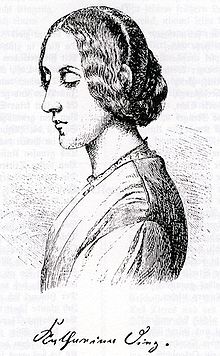Katharina Diez
Katharina Diez (born December 2, 1809 in Netphen near Siegen ; † January 22, 1882 there ) was a German writer .
Life
Katharina Diez was born as one of three daughters of the Keppeler Rentmeister Diez in Netphen, where she spent her childhood and youth. After the death of her parents, she lived with her sister, the writer Elisabeth Grube in Düsseldorf , where she also worked as a writer. In 1846 she moved to Berlin to live with another sister for two years, but returned to her sister Elisabeth in Düsseldorf, where she lived until her death in 1871. Katharina Diez was afflicted by numerous serious illnesses. In Queen Elisabeth of Prussia she found a patroness who appointed the bourgeois Katharina Diez as honorary canon of the noble Keppel monastery near Hilchenbach in 1864 . As a result, she was entitled to a small pension (prebende), but she was not required to live in residence.
After the death of her sister Elisabeth, Katharina Diez moved to Netphen, where she died in 1882. She is buried in the old parish cemetery at Martini Church.
Literary meaning
Central to Katharina Diez's oeuvre are the epics, which often merge into the lyrical and are sometimes written subjectively from the point of view of the writer herself. Her works have been described as excellent, thoughtful and delicate, but it has also been criticized that epic poetry as such loses its character. Her epic poems dealt on the one hand with biblical subjects (e.g. Hagar , Ruth , Abraham's sacrifice , Joseph. Poem based on the Old Testament ), but also with historical figures, such as B. Saint Elizabeth of Hungary or the epic Agnes Bernauer praised by contemporaries .
Together with her sister Elisabeth Grube, Katharina Diez published the two collections of poetry, Liederkranz and Wiesenblumen von der Sieg and Feldblumen vom Rheine . She also worked as a writer for young people and wrote Spring Tales, a work for which Willibald Alexis wrote the foreword in 1851. Her work New Fairy Tales from Forest, Field and Meadow led to comparisons with Gustav von Putlitz ; she also wrote sonnets, short stories, novels and even dramas. The play Frithjof , which was created in 1879, was successfully performed on the court stage in Sigmaringen.
Honor
Today a street in Netphen bears the name of Katharina Diez.
Works
Poetry
- Liederkranz (with Elisabeth Grube, 1842)
- Saint Elisabeth of Hungary, Landgrave of Thuringia (1845)
- St. John's Day (1845)
- Sun King's Bridegroom (1845)
- Meadow flowers from the Sieg and field flowers from the Rheine (with Elisabeth Grube, 1847)
- Seals according to the Old Testament (1852)
- Joseph. Poem based on the Old Testament (1855)
- Agnes Bernauer. Poem (1857)
- Biblical Women (1864)
- Pictures from the war (with Elisabeth Grube and Julie Ludwig , 1866)
- The little stone knocker (undated)
- The filial love victory (undated)
prose
- Easter morning of a sexton. Berlin: Diesterweg u. Kalisch, 1847. Digitized edition of the University and State Library Düsseldorf
- Spring fairy tale (1851)
- New fairy tales from forest, field and meadow (1854)
- Uncle Martin (1859)
- Thoms. From village life (1860)
- A childhood friendship (1861)
- Stephanie, Queen of Portugal (1864)
- To Mexico and back home (1868)
- Editha (1867)
- Heinrich Heine's first love (1870)
drama
- Jephta's Sacrifice (1875)
- Frithjof (play based on Esaias Tegnér , 1879)
literature
- Heinrich Groß: German female poets and writers in words and pictures . 1st volume. Fr. Thiel, Berlin 1885, pp. 318–321.
- Franz Brümmer : Diez, Katharina . In: Allgemeine Deutsche Biographie (ADB). Volume 47, Duncker & Humblot, Leipzig 1903, p. 694 f.
- Joachim Fischer / Ingeborg Längfeld u. a .: Elisabeth Grube & Katharina Diez / Two female poets and their time. Vorländer Verlag, 1992, p. 93
- Kulturforum Netphen: Katharina Diez pp. 2–50
- Franz Brümmer: Lexicon of German poets and prose writers from the beginning of the 19th century to the present . Reclam, Leipzig 1913, p. 26f.
Web links
- Literature by and about Katharina Diez in the catalog of the German National Library
- Katharina Diez in the Lexicon of Westphalian Authors
- NEWW Women Writers database
Individual evidence
- ↑ See Brümmer: ADB, p. 694.
- ↑ In total, she published twelve volumes of popular and youth publications.
| personal data | |
|---|---|
| SURNAME | Diez, Katharina |
| BRIEF DESCRIPTION | German writer |
| DATE OF BIRTH | December 2, 1809 |
| PLACE OF BIRTH | Netphen |
| DATE OF DEATH | January 22, 1882 |
| Place of death | Netphen |
